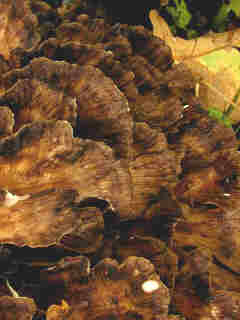
Plant Description
Caution & Interaction

Latin (botanical) name:
Grifola frondosa
Common names: Maitake, Dancing Mushroom, Mushroom, Hen of the Woods
Plant Description: Maitake mushrooms grow deep in the mountains of northeastern Japan. It is also found in the United States, east of the Rocky Mountains. Maitake is a very large mushroom, and can grow to the size of a basketball. It is easily recognizable because of its gray-brown, fan-shaped, wavy caps which are organized in large clusters of rosettes. The surface of the pores is yellowish-white and runs down the stem system. The stem branches are smooth, white, and tough. Maitake is usually found near the bases of hardwood stumps. It also lives on decaying deciduous logs and stumps, and occasionally on living deciduous trees.
Medicinal Properties &Uses: The Maitake mushroom is an adaptogen. Historically, it has been used as a tonic and as food to help promote wellness and vitality. The medicinal properties of the Maitake mushroom have been studied since the mid 1980's. Clinical research of Maitake has increased dramatically over the past several years. Studies have shown Maitake to have anti-tumor, anti-diabetic, and anti-viral properties. In 1992, Maitake's anti-viral activity was confirmed by both National Cancer Institute and the Japan Institute of Health. In addition, the Maitake mushroom has been the subject of research against HIV. This mushroom contains polysaccharides which are among the most powerful studied to-date. The primary polysaccharide, beta-D-glucan, is currently under review for the prevention and treatment of cancer. When taken orally, it is easily absorbed. The Maitake mushroom is a delicious, soft-fleshed polypore with excellent nutritional properties. It's levels of insulin and triglyceride in plasma demonstrated a change similar to blood glucose when eaten. Many studies are continuing on Maitake, including its efficacy in the management of diabetes, high blood pressure, high cholesterol, and obesity.
Dosage: 20-40 drops in water or juice, 2-3 times daily or as needed.
Cautions & Interactions: Keep out of reach of children.
Efficacy Studies & Other Clinical Data:
Disclaimer (U.S. Only): These statements have not been evaluated by the FDA. These products are not intended to diagnose, cure, treat, or prevent any disease.
Common names: Maitake, Dancing Mushroom, Mushroom, Hen of the Woods
Plant Description: Maitake mushrooms grow deep in the mountains of northeastern Japan. It is also found in the United States, east of the Rocky Mountains. Maitake is a very large mushroom, and can grow to the size of a basketball. It is easily recognizable because of its gray-brown, fan-shaped, wavy caps which are organized in large clusters of rosettes. The surface of the pores is yellowish-white and runs down the stem system. The stem branches are smooth, white, and tough. Maitake is usually found near the bases of hardwood stumps. It also lives on decaying deciduous logs and stumps, and occasionally on living deciduous trees.
Medicinal Properties &Uses: The Maitake mushroom is an adaptogen. Historically, it has been used as a tonic and as food to help promote wellness and vitality. The medicinal properties of the Maitake mushroom have been studied since the mid 1980's. Clinical research of Maitake has increased dramatically over the past several years. Studies have shown Maitake to have anti-tumor, anti-diabetic, and anti-viral properties. In 1992, Maitake's anti-viral activity was confirmed by both National Cancer Institute and the Japan Institute of Health. In addition, the Maitake mushroom has been the subject of research against HIV. This mushroom contains polysaccharides which are among the most powerful studied to-date. The primary polysaccharide, beta-D-glucan, is currently under review for the prevention and treatment of cancer. When taken orally, it is easily absorbed. The Maitake mushroom is a delicious, soft-fleshed polypore with excellent nutritional properties. It's levels of insulin and triglyceride in plasma demonstrated a change similar to blood glucose when eaten. Many studies are continuing on Maitake, including its efficacy in the management of diabetes, high blood pressure, high cholesterol, and obesity.
Dosage: 20-40 drops in water or juice, 2-3 times daily or as needed.
Cautions & Interactions: Keep out of reach of children.
Efficacy Studies & Other Clinical Data:
-
Literature on Anti-tumor /Immune Activating Activities - Maitake Mushroom
-
Effects of Maitake (Grifola frondosa) glucan in HIV-infected patients
Disclaimer (U.S. Only): These statements have not been evaluated by the FDA. These products are not intended to diagnose, cure, treat, or prevent any disease.